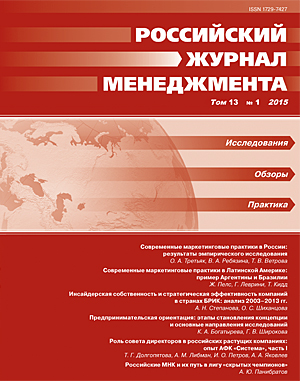Инсайдерская собственность и стратегическая эффективность компаний в странах БРИК:
анализ 2003-2013 гг.
Аннотация
В статье изучается влияние инсайдерской собственности на стратегическую эффективность компаний на развивающихся рынках капитала — в странах БРИК — в период с 2003 по 2013 г. Предложенная авторами модель зависимости стратегической эффективности и собственности инсайдеров представляет собой адаптацию классической модели Морка — Шлейфера — Вишны (1988 г.) к условиям слабоэффективных развивающихся рынков. При модификации традиционной для развитых рынков модели используется концепция, предложенная Ла Портой (2002 г.) и позволяющая учитывать степень защиты прав инвесторов, а также вводятся дополнительные факторы роста и риска. Адаптированная модель тестируется на выборке из 97 нефинансовых компаний Бразилии, России, Индии и Китая в двух спецификациях — кубической и кусочно-линейной. В результате получена значимая немонотонная зависимость: стратегическая эффективность возрастает при сравнительно малых и высоких уровнях собственности инсайдеров (эффект конвергенции интересов) и снижается при средних уровнях инсайдерской собственности (эффект «окапывания»). Диапазон действия эффекта «окапывания» был выявлен на уровне от 23,2 до 61,3% акций в руках инсайдеров. Также было обнаружено усиление влияния эффекта «окапывания» в период мирового кризиса (2008–2009 гг.).
Ключевые слова:
структура собственности, инсайдерская собственность, стратегическая эффективность компаний, корпоративное управление
Скачивания
Библиографические ссылки
The List of References in Cyrillic Transliterated into Latin Alphabet
Загрузки
Опубликован
Как цитировать
Выпуск
Раздел
Лицензия
Статьи журнала «Российский журнал менеджмента» находятся в открытом доступе и распространяются в соответствии с условиями Лицензионного Договора с Санкт-Петербургским государственным университетом, который бесплатно предоставляет авторам неограниченное распространение и самостоятельное архивирование.





